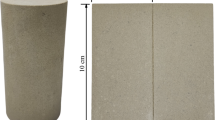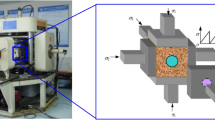Abstract
A simple law of wear rate is examined for the process of gouge generation during the frictional sliding of simulated faults in rocks, by use of the Pi theorem method (dimensional analysis) and existing experimental data. The relationship between wear rate (t/d) and the applied stress can be expressed by the power-law relations
wheret is the thickness of the gouge generated on the frictional surfaces,d is the fault displacement, σ and τ are normal stress and shear stress, respectively, andC σ,C τ,m σ andm τ are constants. These results indicate that the exponent coefficientsm σ andm τ and the coefficientsC σ andC τ depend on the material hardness of the frictional surfaces. By using the wear rates of natural faults, these power-law relationships may prove to be an acceptable palaeopiezometer of natural faults and the lithosphere.
Similar content being viewed by others
References
Allègre, C. J., Le Mouel, J. L., andProvost, A. (1982),Scaling Rules in Rock Fracture and Possible Implications for Earthquake Prediction, Nature297, 47–49.
Archard, J. F. (1953),Contact and Rubbing of Flat Surface, J. Appl. Phys24, 981–988.
Archard, J. F.,Wear. InInterdisciplinary Approach to Friction and Wear (ed. Ku, P. M.) (NASA Sp-181, Washington, 1968).
Archard, J. F., andHirst, D. (1956),The Wear of Metal Under Unlubricated Conditions, Proc. Roy. Soc. London, Ser. A.236, 397–410.
Aviles, C. A., Scholz, C. H., andBoatwright, J. (1987),Fractal Analysis Applied to Characteristic Segments of the San Andreas Fault, J. Geophys. Res.92, 331–344.
Birkhoff, G.,Hydrodynamics (Princeton Univ. Press, New York, N.Y., revised edition 1960).
Bridgman, P. W.,Dimensional Analysis (Yale Univ. Press, New Haven, Conn. 2nd ed. 1931).
Brown, S. R., andScholz, C. H. (1985),Broad Bandwidth Study of the Topography of Natural Rock Surfaces, J. Geophys. Res.90, 12572–12582.
Buckingham, E. (1914),On Physically Similar Systems; Illustrations of the Use of Dimensional Equations, Phys. Rev.4, 345–376.
Burwell, J. T. (1957),Survey of Possible Wear Mechanisms, Wear1, 119–141.
Burwell, J. T. (1958),Wear of Metals, Wear1, 317–332.
Burwell, J. T., andStrang, C. D. (1952),On the Empircal Law of Adhesive Wear, J. Appl. Phys23, 18–28.
Czichos, H.,Tribology, Tribology Series. 1 (Elsevier Sci. Publ. Comp., Amsterdam 1978).
Ebihara, K., andHayashi, K. (1959),An Application of Dimensional Analysis to the Characteristics of Wear in Absence of Lubricant, Trans. Japan Soc. Mech. Engrs.25, 458–464 [in Japanese with English abstract].
Engelder, J. T. (1974),Cataclasis and the Generation of Fault Gouge, Bull. Geol. Soc. Am.85, 1515–1522.
Focken, C. M.,Dimensional Analysis and their Applications (Edward Arnold and Co., London 1953).
Fletcher, P., andGay, N. C. (1971),Analysis of Gravity Sliding and Orogenic Translation: Discussion, Bull. Geol. Soc. Am.82, 2677–2682.
Holm, R.,Electric Contacts (H. Gebers Föralag, Stockholm 1946).
Hubber, K. (1937),Theory of Scale Models as Applied to the Study of Geological Structures, Bull. Geol. Soc. Am.48, 1459–1520.
Hull, J. (1988),Thickness-displacement Relationships for Deformation Zones, J. Struct. Geol.10, 431–435.
Jaeger, J. C., andCook, N. G. W., Fundamentals of Rock Mechanics (Chapman and Hall, London 1969).
Kojima, K., Ohtsuka, Y., andYamada, T. (1981),Distributions of Fault Density and “Fault Dimension” in Rockmass and Some Trials to Estimate Them, J. Japan Soc. Engr. Geol.22, 88–103 [in Japanese with English abstract].
Lanchester, F. W.,Theory of Dimensions and its Application for Engineers (Crossby, Lockwood and Sons, London 1936).
Langhaar, H. L.,Dimension Analysis and Theory of Models (Wiley, New York, N.Y. 1951).
Lätzig, W.,Die Grundlagen und ihre praktische Anwendung (Carl Hanser, München 1950).
Matsunaga, M.,Lapping (Seibundo Shinkousha, Tokyo 1957) [in Japanese].
Mitra, G. (1984),Brittle to Ductile Transition due to Large Strains along White Rock Thrust, Wind River Mountains, Wyoming, J. Struct. Geol.6, 51–61.
Miyata, T. (1978),Movement Picture of the Median Tectonic Line along the Southern Margin of the Izumi Mountain-range, MTL (Publication of Median Tectonic Line Research Group), no.3, 73–77 [in Japanese].
Morohashi, S., Kato, S., Sawahata, Y., andYashima, S. (1973a),Formation of Ultrafine Powders by a Reciprocating Friction Mill, J. Res. Assoc. Powder Tech. Japan10, 316–323 [in Japanese with English abstract].
Morohashi, S., Sawahata, Y., andYashima, S. (1973b),Effect of Operational Conditions on the Formation of Ultrafine Powder by a Reciprocating Friction Mill, J. Soc. Mater. Sci. Japan22, 689–692 [in Japanese with English abstract].
Nagahama, H. (1991),Fracture in the Solid Earth, Sci. Rep. Tohoku Univ., 2nd ser. (Geol.)61, 103–126.
Otsuki, K. (1978),On the Relationship between the Width of Shear Zone and the Displacement along Fault, J. Geol. Soc. Japan84, 661–669.
Power, W. L., Tullis, T. E., Brown, S. R., Boitnott, G. N., andScholz, C. H. (1987),Roughness of Natural Fault Surfaces, Geophys. Res. Lett.14, 291–294.
Power, W. L., Tullis, T. E., andWeek, J. D. (1988),Roughness and Wear during Brittle Faulting, J. Geophys. Res.93, 15268–16278.
Queener, C. A., Smith, T. C., andMitchell, W. L. (1965),Transient Wear of Machine Parts, Wear8, 391–400.
Quinn, T. F. J. (1967),The Effects of “Hot Spot” Temperature on the Unlubricated Wear of Steel, ASLE Trans.10, 158.
Rabinowicz, E.,Friction and Wear of Materials (John Wiley and Sons, Inc. New York 1965).
Robertson, E. C.,Continuous formation of gouge and breccia during fault displacement. InIssues in Rock Mechanics (eds. Goodman, R. E., and Scholz, C.) (Amer. Inst. Mining Engineering, New York 1982) pp 397–404.
Robertson, E. C. (1983),Relationship of Fault Displacement to Gouge and Breccia Thickness, Mining Engineering35, 1426–1432.
Rowe, C. N. (1966),Some Aspects of Heat of Absorption in the Function of a Boundary Lubricant, Trans. Am. Soc. Lubric Engrs.9, 100–111.
Scholz, C. H. (1987),Wear and Gouge Formation in Brittle Faulting, Geology15, 493–495.
Scholz, C. H., andAviles, C. A.,The fractal geometry of faults and faulting. In:Earthquake Source Mechanics (eds. Das, S., Boatwright, J., and Scholz, C. H.) (Geophysical Monogr. 37, Maurice Ewing. 6. AGU. Washington D.C. 1986) pp. 147–155.
Segall, P., andPollard, D. (1983),Nucleation and Growth of Strike-slip Faults in Granite, J. Geophys. Res.88, 555–568.
Segall, P., andSimpson, C. (1986),Nucleation of Ductile Shear Zones on Dilatant Fractures, Geology14, 56–59.
Shimamoto, T. (1974),Application of the Pi Theorem to the Similarity Criteria of Slow Deformation of Inhomogeneous Viscous Fluids, Tectonophysics22, 253–263.
Skoglund, V. J.,Similitude Theory and Applications (International Textbook, Scranton, Pa. 1967).
Sods, N., andAoki, A. (1959),On Fretting Corrosion, Trans. Japan Soc. Mech. Engrs.25, 1005–1010 [in Japanese with English abstract].
Tabor, D. (1954),Mons's Hardness Scale: A Physical Interpretation, Proc. Phys. Soc. Sr.B67, 249–257.
Takahashi, K. (1938),On a Property of Power Mass and Character of Cracks, and their Application to Geophysical Problems, J. Meteorol. Soc. Japan16, 451–454 [in Japanese].
Teufel, L. W.,Pore volume changes during frictional sliding of simulated faults. InMechanical Behavior of Crustal Rocks, Geophys. Monogr. no. 24 (eds. Carter, N. L., Freidman, M., Logan, J. M., and Stearns, D. M.) (AGU, Washington, D.C. 1981).
Yoshioka, N. (1985),Temperature Measurement during Frictional Sliding of Rocks, J. Phys. Earth33, 295–322.
Yoshioka, N. (1986),Fracture Energy and the Variation of Gouge and Surface Roughness during Frictional Sliding of Rocks, J. Phys. Earth34, 335–355.
Author information
Authors and Affiliations
Rights and permissions
About this article
Cite this article
Nagahama, H., Nakamura, N. Application of the Pi theorem to the wear rate of gouge formation in frictional sliding of rocks. PAGEOPH 142, 795–808 (1994). https://doi.org/10.1007/BF00876065
Received:
Revised:
Accepted:
Issue Date:
DOI: https://doi.org/10.1007/BF00876065




